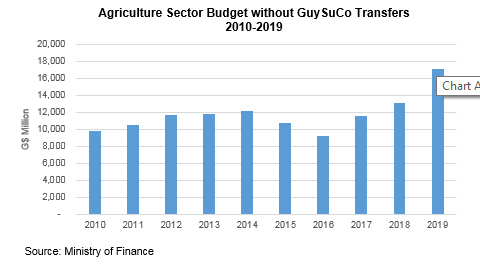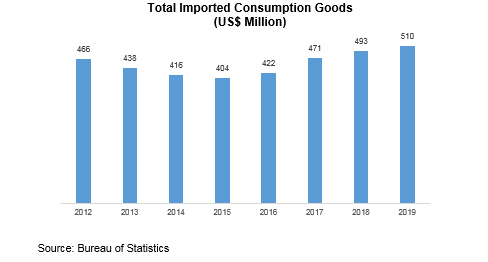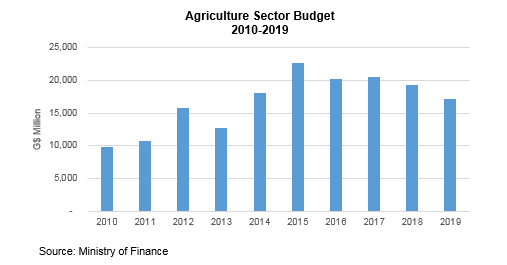Dear Editor,
On July 22, 2020, Stabroek News carried a letter titled `State of economy is likely to worsen more than casually projected’, in which the author conjures Guyana’s economy being in distress at the end of the first quarter, a situation he blames on alleged poor management and policy. However, in the absence of any supporting evidence one, obviously, must question the basis of his many assertions. Allow me to put forward some evidence that not only rebuts many of the claims made, but, also, emphasises to your readers the importance of reviewing publicly available data for their own benefit, and not take as “gospel” the opinions of every “expert”.
As highlighted in the 2019 End of Year Outcome Statement, Guyana’s economy grew in real terms, in 2019, by 5.4 percent, with the non-oil economy growing by 4.3 percent. This persisted into the first quarter of the year. However, we must keep in mind that Guyana’s first COVID-19 case was reported in March and resulted in several emergency measures being implemented to ensure the safety of Guyanese, which would have stymied economic activity since then. Additionally, the absence of a national budget and the protracted delay in finalising the General and Regional Elections would have also dampened further economic expansion this year. Despite these challenges, our economy is not on the verge of collapse. Indeed, the outlook is for real economic growth in excess of 40 percent.
Consumption and Economic Collapse
In a subsequent interview with Guyana Diaspora News, the author notes that consumption spending is drying up and the economy is on the verge of collapse. He offers no data to support this conclusion. Here are some numbers to consider: Using total imported consumption goods as a proxy for overall consumption, we see that since 2015, there has been an upward trend (see chart below), with preliminary numbers for 2020 Q1 indicating growth of approximately 6.3 percent, or US$6.4 million, over the same period in 2019. The growth from 2019 spilled over to 2020, as the wholesale and retail trade industry continued to expand in 2020 Q1 amid notable demand. Total imported consumption goods were supported by food for final consumption, “other durables” and motor cars.
Obviously, the pandemic would have led to many households and businesses changing their spending priorities and patterns. This is the reality of the pandemic and Government continues to work within budgetary constraints to ensure that all are able to meet their basic needs. Since March, some of the measures put in place to help the citizens include tax waivers on medical supplies, deferment of payment of both corporate and individual advance taxes and PAYE, deferred loan payments, debt deferrals for up to six months for University of Guyana students, grants to small businesses, and food vouchers and hampers for those most affected by the pandemic. Government has also drafted several other measures to help accelerate post-pandemic growth, which, unfortunately, cannot be implemented within the current environment.
Support to Agriculture
Moving on, the author joins a long list of detractors who seek to politicize the downsizing of the sugar
industry, categorizing it as part of some “ill-conceived scheme” with racial undertones. As is known, publicly, in 2014, the Wales, Skeldon and Enmore estates operated at losses in excess of $1.5 billion. Guysuco was incurring massive losses and racking up huge debts, in the process, putting excessive pressure on the Treasury. We cannot ignore the fact that the closed estates were not viable. With new restructured, cost profiles, the remaining estates were given an opportunity to succeed. With the backing of the Government, a $30 billion bond has been secured and, hopefully, an inefficient public corporation, heavily dependent of the Treasury for survival, can become a model to be emulated, producing about 150,000 tonnes of sugar in the medium term.
With respect to the administration starving the agriculture sector of essential funding, I would like to draw your attention to the charts below.
In 2015, when this government took office, the support to the agriculture sector through the national budget increased by approximately 25 percent, or from $18.1 billion, in 2014, to $22.7 billion, in 2015. Post 2015, it appears as though budgetary allocations declined. However, once we consider Government transfers to GuySuCo – and exclude those from the figures – a truer picture of the allocations to the agriculture sector is gleaned.
For the period 2010 to 2014, approximately $11 billion was budgeted to be transferred to GuySuCo. In 2015 alone, the budgeted support for the ailing corporation exceeded this amount, to reach $12 billion. For the period 2015 to 2019, the total budgeted transfers to the corporation was $38 billion. What does this mean? In 2015 and 2016, more than half of the budgeted sums to the sector were for transfers to GuySuCo. This meant that the available support for other sub-sectors was significantly reduced. Once the substantial transfers to GuySuCo declined, and eventually disappeared, the funds available for other sub-sectors within agriculture rose, from $11.6 billion in 2016 to $17.1 billion in 2019. Clearly this sector has not been starved of essential funding.
Additionally, despite the author’s claim, this Government has placed much emphasis on the promotion of non-traditional agriculture. Since 2015 we have invested every year in the promotion of agricultural diversification in the urban, rural, hinterland and riverain communities and in the intermediate and Rupununi savannahs. Government has supported the development of agricultural research through investment in research stations and demonstration farms in areas like Ebini, Hosororo and Mabaruma, all geared toward non-traditional crop production and development across the country. It is important to also highlight that through the Ministerial Roundtable engagement with the Guyana Manufacturing and Services Association, Government has worked alongside the private sector to catalyse the manufacturing sector, particularly agro-processing, by addressing issues such as taxation, access to land, and transportation and trade barriers. One notable achievement, in this regard, is the reduction of the corporation tax rate for non-commercial companies from 30 percent to 25 percent. I have provided the evidence that this Government has in no way starved the agriculture sector. Can he do the same to support his contrary view?
Taxes on Households
In making his claim that the administration sought to “tax its way to prosperity”, the author failed to examine the multiple measures put in place to increase the disposable incomes of households. Unquestionably, since 2015, tax policy and administration have evolved to rid the tax system characterized by inequality and unfairness. In pursuit of this, no new tax was introduced. On the contrary, rates were reduced, thresholds increased, and duty and tax concessions were granted to a range of sectors, items and individuals.
For example, the rate of VAT was reduced to 14 percent; the corporation tax rate for companies in manufacturing and non-commercial activities was reduced from 30 percent to 25 percent; the income tax threshold was increased from $600,000 to $780,000 or 1/3 of gross income, whichever was higher – resulting in more than 70,000 persons being removed from the tax register; the personal income tax rate fell from 30 percent to 28 percent for individuals whose chargeable income fell between $65,000 and $195,000 per month; private sector employees now enjoy tax-free vacation allowances; the removal of VAT on low-income housing; the property tax rate for both individuals and companies was reduced, and the list goes on. The Government can boast, without fear of being contradicted, that no Government has done more in its first term in office.
We must refrain from making statements without providing context for readers. The Government’s intention was to broaden the tax base and use revenue gains to improve equity in the tax system. Primarily, the intention was to lower the income tax – and other tax – burdens on the low-income groups. The author seems to be subscribing to the narrative that higher collections means taxes have increased. Instead, what is clear is that the Guyana Revenue Authority has improved their processes significantly and closed loopholes to ensure that many individuals and businesses, who for one reason or the other were not paying their fair share of taxes before 2015, are made to pay their fair share – a move that did not find favour with some businesses who grew accustomed to lax enforcement. In passing, the author is informed that the 9-month amnesty, announced in 2018, netted $10 billion in arrears, most of it from the mining sector.
Foreign Asset Holdings and Non-Performing Loans
The author claims that Government liquidated $23 billion worth of foreign asset holdings and attempts to paint a picture of doom for the Guyanese people. I wish to re-emphasize some points made in my letter to this paper on July 11. Our country’s foreign reserves are used principally to service our external debts, pay for fuel imports for GPL and intervention in the foreign exchange market, periodically. During the first quarter of this year, total imports amounted to US$609.4 million, of which the oil and gas sector imports accounted for 34.4 percent. Oil and gas sector imports are financed almost exclusively by foreign direct investments. Hence, in order to capture the adequacy of our reserves, we should assess our reserves against the total value of imports excluding oil imports. For the period January to March 2020, existing data shows that total non-oil imports amounted to US$397.5 million or US$132.5 million on average per month. At this rate, our foreign reserves are adequate to cover more than 3 months of imports – the foreign reserves of the Bank of Guyana totalled US$499.2 million at end of March 2020, covering 3.8 months of such imports.
According to the author, another indicator that confirms his “underlying distress of the economy” is the state of non-performing loans. Indeed, non-performing loans increased to 10.1 percent of total loans, from 8.5 percent in the first quarter of 2015. What the author neglects to highlight, however, is that the 0.8 percentage points improvement in 2020 is in fact the second year to record an improvement. In 2019, the ratio was 10.9 percent, down from 11.6 percent in 2018. What this means is that, from the first quarter of 2018 to the same period in 2020, the ratio improved by about 1.5 percentage points.
Exports and Production
In his letter, the author correctly mentions that the gold export earnings continue to increase, moreso growing by 5.5 percent in 2019 when compared with 2016. This is an achievement and resulted in the total export earnings increasing by 9.2 percent in 2019 when compared with 2016, with 2019 recording the highest level of export earnings ever. While the author hurriedly points to sectors which have seen declines in export earnings for one reason or the other, he unashamedly reveals his bias by choosing to ignore others that have recorded notable gains, such as rice exports, which, from 2016 to 2019 grew by 24.6 percent, or bauxite exports, which grew by 27.5 percent over the same period. Then, again, these do not fit the doom and gloom, ‘sky is falling’ narrative that he and his ilk seek to portray.
Government Savings
The author next proceeds to highlight the deterioration of Government deposits over the past five years, a downward trend which started in 2011, after deposits peaked at $68.7 billion in 2010. I must emphasize that this does not mean the country is bankrupt, as is an idea being tossed around recently.
Simply put, the decline in Government deposits resulted from intertemporal outflows to finance budget deficits across several fiscal years. Traditionally, the sum by which the budget deficit exceeded external financing was treated as a residual, with no specific domestic instruments assigned. Consequently, the deficit ended up being financed in part by government deposits, giving rise to a continuous decline, and, eventually to the overdraft of $81.3 billion at July 7, 2020. Unfortunately, our efforts to formalize domestic debt arrangements, by way of a public debt management legislation and ensuing regulations, which would see the issuance of longer term instruments to finance domestic debt, was derailed by the no-confidence motion.
State of the Economy
The author challenges the Central Bank’s estimates, which show increased output in agriculture and gold, and mixed performances in services and construction; yet, he is confident enough to claim a “distressed state of the economy”. What indicators show a state of distress? Certainly, not on the evidence I have presented. Unlike him, I have given prominence to the growing sectors as well as highlighting the sectors that have not done so well. Rice is projected to grow for the fourth consecutive year, to reach 700,000 tonnes, having already seen increased production during the first half of 2020, when compared with the same period last year. We can only continue to exhort your writers/analysts/commentators to undertake evidence-based analysis and leave the politicking to the politicians. Your readers deserve nothing less.
Yours faithfully
Winston Jordan
Minister of Finance






